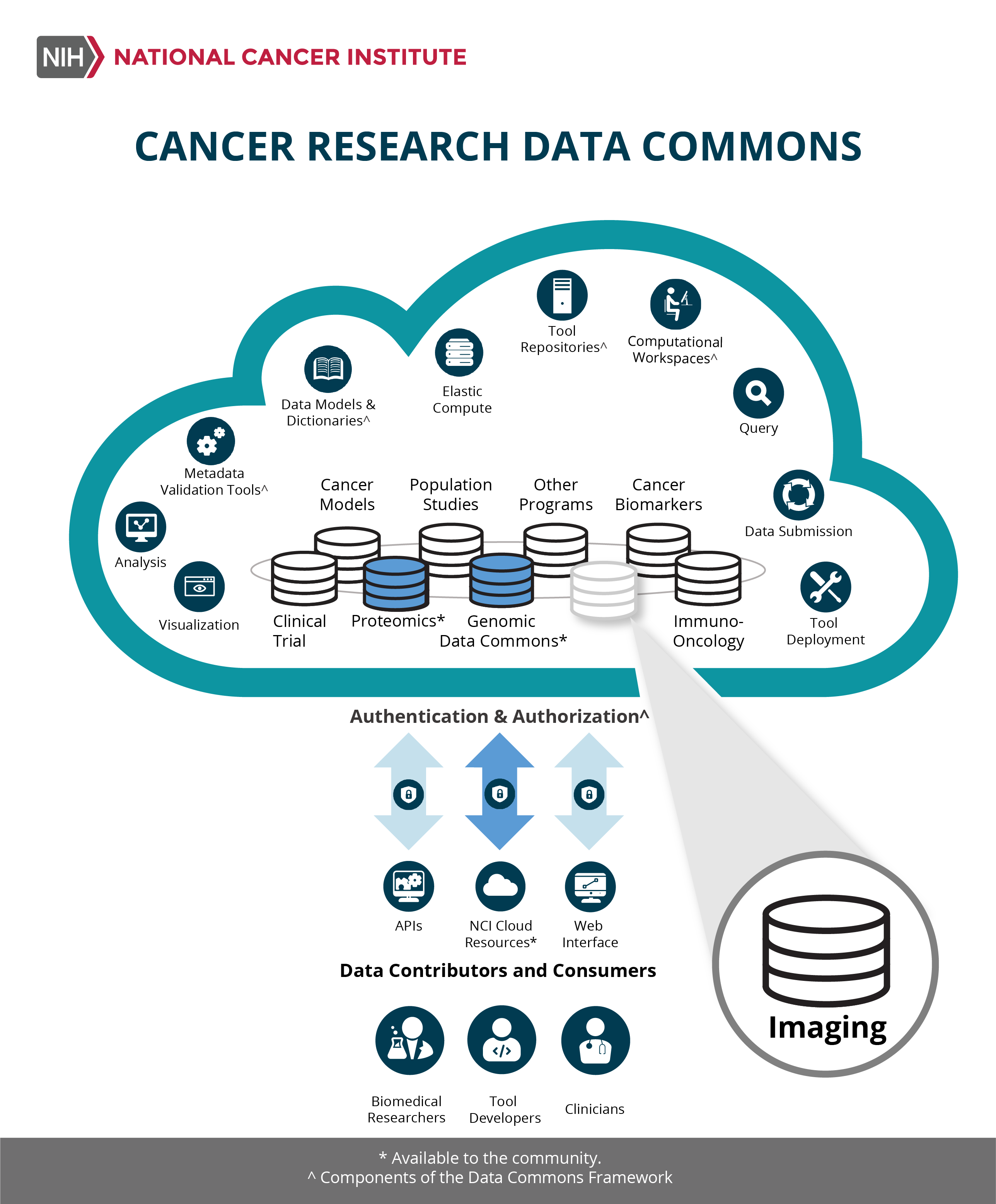Cancer Data Science Pulse
Award of the Imaging Data Commons: Bringing Multi-modal Imaging Data to the Cancer Research Community
On behalf of CBIIT, I am pleased to announce the award of the Imaging Data Commons (IDC) to a consortium led by investigators from the Department of Radiology at Brigham and Women’s Hospital and Harvard Medical School. This contract was awarded through Leidos Biomed and is funded by the Cancer Moonshot℠ in support of the National Cancer Data Ecosystem. The IDC will house multi-modal imaging data and make them available for use by the broader cancer research community.
“This project offers a unique opportunity in cancer imaging to establish and refine best practices for cloud-based imaging data analysis and stewardship. Our team has all the skills needed for the project and for engaging the NCI community. The team brings together experts in cloud-based infrastructure, visualization, analytics, security, data standards, open source development, and outreach,” says Ron Kikinis, M.D., principal investigator of the project and a physician scientist in the Department of Radiology at the Brigham and Women’s Hospital.
The IDC will join the Genomics Data Commons (GDC) and Proteomics Data Commons (PDC) as the newest component of the NCI Cancer Research Data Commons (CRDC). The IDC will allow researchers to apply resources from Google Cloud and leverage the work done at the Institute for Systems Biology Cancer Genomics Cloud (ISB-CGC), which is one of the NCI Cloud Resources that CBIIT has supported over the last several years.
Like the ISB-CGC, the IDC will build upon Google-provided tools such as BigQuery and the Google Healthcare API, which supports Digital Imaging and Communications in Medicine (DICOM), HL7v2, and Fast Healthcare Interoperability Resources (FHIR) standards. The development and integration of additional tools and functionality will further enhance the IDC platform for a wide range of collaborative cancer research use cases, including identification of data of interest, cohort formation, and analysis using the cloud resources of the CRDC. The IDC will start by housing existing radiology and digital pathology (whole slide) data from The Cancer Imaging Archive (TCIA) and in the future will expand to support data from important projects, such as the Human Tumor Atlas Network (HTAN). Image viewing and annotation tools will be early features of the IDC. Additionally, the IDC will integrate imaging datasets with community-contributed derived data and serve as a hub for promoting a variety of community standards, such as DICOM.
“One of the features we are most excited to incorporate into the IDC is the support of the rich standardized metadata that will accompany both images and image-derived datasets,” according to Andriy Fedorov, Ph.D., technical lead for IDC and a researcher in the Department of Radiology at Brigham and Women’s Hospital. “Development of the IDC is a crucial milestone for the imaging community. We need to develop a clear understanding of what is the meaning of “FAIR data” (that is, data practices that promote Findability, Accessibility, Interoperability, and Reusability) in cancer imaging and to operationalize the FAIR principles for cancer imaging research. One of the objectives of the IDC Team is to create the infrastructure and incentives for the scientists to generate and use FAIR data.”
The IDC investigators stress that the project will leverage the investment and expertise accumulated by the team through their involvement in numerous synergistic projects and collaborations. In addition to the valuable experience of the ISB and General Dynamics IT (GDIT) teams participating in the cloud resource project, the investigators have long been funded grantees of the NCI Quantitative Imaging Network (QIN) (Fedorov and Aerts) and Informatics Technology for Cancer Research (ITCR) (Kikinis, Fedorov, Aerts, Pieper, and Clunie) initiatives. Those projects were invaluable for building understanding of imaging needs and developing collaborations that led to the IDC proposal. One such key collaboration established through ITCR is with the Open Health Imaging Foundation (OHIF) project. The IDC Team plans to utilize open source visualization components developed by OHIF as key components of the infrastructure.
All the tools developed by the project will be available under non-restrictive open source licenses.
The members and leadership of the IDC consortium are:
• Surgical Planning Laboratory at Brigham and Women’s Hospital Department of Radiology and Harvard Medical School: Ron Kikinis, M.D., and Andriy Fedorov, Ph.D.
• Institute for Systems Biology: William Longabaugh and Ilya Shmulevich, Ph.D.
• General Dynamics IT: David Pot, Ph.D.
• Isomics: Steve Pieper, Ph.D.
• Fraunhofer MEVIS: André Homeyer, M.D. and Rasmus Kiehl, M.D.
• PixelMed Publishing: David Clunie, M.D.
• Computational Imaging and Bioinformatics Laboratory at Dana Farber Cancer Institute and Harvard Medical School: Hugo Aerts, Ph.D.
Everyone at NCI congratulates the IDC Consortium, and we all look forward to the new discoveries in cancer research the Imaging Data Commons will enable.
Categories
- Data Sharing (64)
- Informatics Tools (38)
- Training (38)
- Genomics (35)
- Data Standards (34)
- Data Commons (32)
- Precision Medicine (30)
- Data Sets (25)
- Machine Learning (22)
- Seminar Series (22)
- Artificial Intelligence (19)
- Leadership Updates (12)
- Imaging (12)
- Policy (9)
- High-Performance Computing (HPC) (9)
- Jobs & Fellowships (7)
- Funding (6)
- Proteomics (5)
- Semantics (5)
- Information Technology (2)
- Publications (2)
- Awards & Recognition (1)
- Childhood Cancer Data Initiative (1)
- Request for Information (1)


Leave a Reply